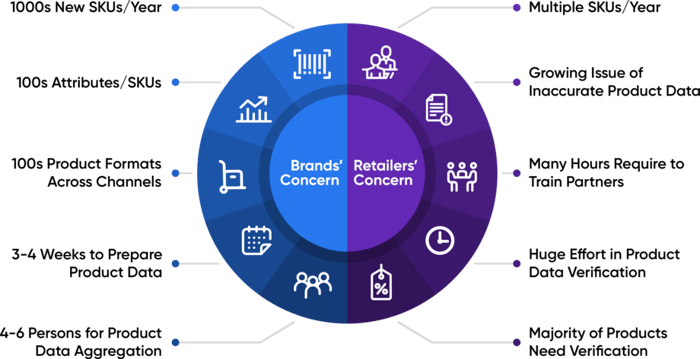
Enterprises now recognize product data as a valuable asset, especially in their digital business initiatives. The reason: product data is becoming one of the core components of an overall enterprise data management strategy. Stakeholders across consumer-facing industries are profoundly focusing on rich product information in a wide array of use cases, including eCommerce, mCommerce, pricing optimization, supply-chain efficiency, advanced inventory modeling, process automation, and unified commerce enablement.
But many enterprises may struggle to unlock deeper business values and create differentiated consumer experiences if their product information is not consistent and accurate across the value chain. Managing and streamlining every aspect of product information is a must for global standardization, channel flexibility, and implementation feasibility for multiple touchpoints. And, it is an essential first step toward leading in digital and omnichannel maturity.
The Complex State of Managing Product Data
Enterprises today invest a decent amount of time, money, and resources in managing foundational product data. Different enterprises have a different set of requirements to streamline and make their product data consumer-ready in a wide range of formats. Moreover, product information management requirements may differ widely across regions and product categories. This all demands huge efforts and time.

1. Uncertainty in PIM
Enterprises are often uncertain about the purpose and value of product information management (PIM). It is a growing challenge for them
2. Unrealized Potential
Enterprises that have already adopted PIM have not yet grasped its full potential for customer experiences. This further adds more complexity to the system.
3. Missed Opportunities
Without an expanded focus to seamlessly distribute product data to multiple touchpoints, many enterprises may miss new business opportunities.
Course of Action: How to Maximize the PIM Value
Bringing the best out of your product data begins with excellence in identifying, capturing, and storing that data; moves through the technical capability to consolidate, organize, and enrich that data; and ends with seamless distribution across multiple customer touchpoints and stakeholders. Organizations need to standardize, optimize, and enrich product information consistently, holistically, and analytically to unlock newer business insights and opportunities.
Build Uniformity in Product Data
Create a uniform and standardized product information by connecting rich product content ( marketing description, features and benefits, cross-sell/upsell, and user-generated content), digital assets (pictures, documentation, videos, and CAD), and product master data ( SKUs, product weight, dimensions, color/size variants, and materials/ingredients). You can achieve this with the utilization of a PIM solution that integrates data from many sources, including MDM and DAM. This also helps you support your customer-centric experiences.
A PIM system provides product managers, marketing, and commerce teams with the ability to create, maintain, and draw on a single version of truth of rich product content and digital assets for driving multichannel marketing and unified commerce. Along with that, a PIM/MDM system can support a centralized use case, with product data authored in the MDM hub and synchronized with all downstream applications.
Impact on Business Results
With accurate, consistent, and higher quality product information, buyers can search and evaluate products more quickly and easily, thus helping them make better decisions. While engaging with different clients, Pimcore team generally hears from clients that their customer engagements have improved more than 40% due to better product data availability and searchability across various channels.
Extend the Horizon of Your Product Data
There is an increasing need to create customer-centric experiences across devices (such as mobile and desktop) and channels (direct and indirect). In digital commerce, you must use product data and content to tailor the experience to better target, attract and engage customers, and drive purchasing behavior. A holistic product view should be employed to create relevant customer-centric experiences, such as unified retail commerce.
However, to achieve this aim, your product data needs to evolve from a silo identity to an integarted one. You should also extend the holistic view of product data by collecting and connecting behavioral data assets — including transactional, interactional, observational, and unstructured data, and analytics — to product master data. But, you may need new applications and infrastructure in aligned with your people and process to enable the complete view of your products.

Impact on Business Results I
An optimized product data can speed product launches by reducing delays due to data gaps and errors. It also helps eliminate barriers to gaining valuable customer insights. You can easily manage millions of SKUs with thousands of attributes. We have observed with our customers that the more integrated and consistent their product data was, the more they could reach their target market, ultimately increasing their sales and revenue up to 20%.
There is a growing demand for personalized and automated shopping experiences with one-day delivery. Personalization is critical now— to be relevant to the customer and tailor the experience to their context. Customers will need enhanced virtual product-buying support, online inventory and pick/pack or delivery capability. You need to address these challenges in a quick turnaround time. But manually it is not possible.
To keep manual effort and onboarding time to the bare minimum, automation comes particularly handy in areas like auto-categorization of products from product description, enrichment from product description, and data standardization of product descriptions or other product attributes. It even helps you associate appropriate digital assets – such as images, videos or product brochures – with the exact corresponding product. Thus, only the correct assets get syndicated to downstream channels—eCommerce, mobile, POS or marketing collateral.
Impact on Business Results II
Automation of product data leads to increased consistency, context, and reliability of product data, which are prerequisites for creating value with machine learning, artificial intelligence, and other technologies. Automation capabilities with PIM give powerful competitive advantages, such as personalized offers and dynamic pricing. With Pimcore, many of our clients have achieved encouraging results from automation like a single source publishing across multi channels. It has dramatically improved their productivity (40%), reduced costs (15%), and facilitated smart processes.
Data governance reduces the complexity of product data management and quality issues, and, over time, it minimizes the number of data-related legal incidents, compliance and regulatory issues, and physical product verification errors. As more data becomes available in standard formats with availability, usability, integrity, and security, enterprises can easily exploit it for agility and scalability. Moreover, they will harness more consistent data to find valuable new insights and opportunities from advanced analytics.
Data governance, management, and integration with a PIM system is much simpler because enterprises no longer need to create new models for each new category, allowing them to reuse data or extend their functionality for various purposes. Enterprises can also seamlessly integrate product data into their existing IT landscape and create a single source of truth. This ensures that every person in the organization always has access to up-to-date product data.
Impact on Business Results III
With integrated and streamlined product information, enterprises can unlock possibilities of creating new offers and providing seamless customer experience. It also allows operational teams to have a single, trusted version to access the latest data and avoid data duplication. Many Pimcore’s clients have revealed that they were able to create new sales opportunities, reduce costs, grow customer loyalty with better data governance. Many of them have even achieved approximately 30% improvement in their operational efficiency.
Quick Tips on PIM Implementation
Enterprises can turn product data into business values by implementing the right process and tools. A systematic approach maps a series of actions to the insights value chain and builds the tools and governance that support sustained engagement around these insights-based activities. But enterprises must make a conscious effort and investment while adopting and implementing a PIM system to get the maximum business results. While implementing PIM software, here are a few things you should consider:
- Collect non-master product data, regardless of its volume, velocity, structure, or origin.
- Analyze gaps between their existing product data management process and the industry-standard model.
- Co-locate trusted master data, enriched product data and product-specific assets.
- Take stringent data quality measures for ensuring neat and clean data.
- Identify necessary changes in the systems for maximum utilization of product data, including external interfaces.
- Keep in mind your data-and-technology maturity & the extent of differences between the current models and the new one.
- Perform a pilot test and then scale steadily.
- Initiate the complete migration.
- Enable effective analytics to deliver product intelligence in order to achieve fast, reliable insights and decision.
In many cases, enterprises will also need to update existing product data to comply with the new standard. This also demands training their relevant employees to get the maximum value from their product information. All in all, PIM is a safe bet for enterprises of any size.
Pimcore's open source product information management (PIM) software centralizes and harmonizes all your marketing, sales and technical product information. It can acquire, manage and share any type of digital data and is designed for easy integration into existing IT system landscapes.
- Flexibility and adaptability for innovation
- Shorter time-to-market for competitive edge
- Omni-channel compatibility for enriched experience
- Implement in multidomain, multivector, and infrastructure of choice
- Lower total cost of ownership

